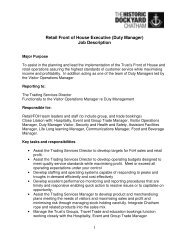Sports Management Issue 1 2012 - Leisure Opportunities
Sports Management Issue 1 2012 - Leisure Opportunities
Sports Management Issue 1 2012 - Leisure Opportunities
You also want an ePaper? Increase the reach of your titles
YUMPU automatically turns print PDFs into web optimized ePapers that Google loves.
According to APS data, the number<br />
of people cycling regularly in 2010/11<br />
grew by 126,400 since 2005/6<br />
CASE STUDY:<br />
ENGLAND NETBALL – USING INSIGHT TO DRIVE PARTICIPATION<br />
T<br />
he Active People Survey (APS)<br />
shows that netball participation<br />
has grown by 18 per cent over<br />
the last five years, partly due to the<br />
success of programmes such as England<br />
Netball’s Back to Netball. This hasn’t<br />
happened by chance, but is built on<br />
the commitment the governing body<br />
has shown to putting their participants<br />
at the heart of everything they do –<br />
the Participant-Centred Approach.<br />
Over the last 18 months, England<br />
Netball has undertaken a huge project<br />
to identify the behaviours, motivations,<br />
expectations, capabilities and<br />
needs of current netballers and potential<br />
future participants to help shape<br />
their offers, programmes and structures.<br />
They have combined information<br />
from a wide range of surveys, audits,<br />
questionnaires, in-depth interviews<br />
and recorded conversations. Through<br />
The Big Netball Conversation, the<br />
governing body has talked directly to<br />
nearly 10,000 netballers.<br />
Data and insight derived from the<br />
APS has been a key component of this<br />
process. It has particularly supported<br />
understanding of the large number of<br />
participants accessing netball activities<br />
outside the sport’s traditional structures.<br />
While England Netball has a<br />
membership of just over 50,000 adult<br />
members, more than 130,000 on average<br />
play netball once a week.<br />
The customer-centred understanding<br />
is already driving the development<br />
of the ‘My Game’ portfolio of<br />
offers for current and potential netball<br />
players aimed at offering a game and<br />
product of choice for any participant<br />
and it will underpin the continuing<br />
evolution of England Netball’s strategic<br />
plan. The sport will also be continuing<br />
to talk to participants and building<br />
understanding of their needs as new<br />
data emerges – as with all successful<br />
organisations, the path to success<br />
starts and ends with understanding<br />
their customers.<br />
4.24 million, women’s participation has<br />
failed to keep pace. It’s clear from this<br />
that more needs to be done to make<br />
sport attractive to women.<br />
SPORT BY SPORT<br />
With six years data to look at, what do<br />
we know about the relative popularity of<br />
different sports Sport England measures<br />
the sports it funds on the number of<br />
people who are playing the sport at least<br />
once a week for 30 minutes.<br />
Among team sports, the picture in<br />
2010/11 looks similar to six years ago;<br />
football remains far out in front with<br />
over 2.1 million weekly participants, followed<br />
by cricket, rugby union, basketball<br />
and netball. The most likely change to<br />
that order appears to be among the final<br />
two, with netball showing a positive<br />
trend and basketball flagging, particularly<br />
in the last two years of APS figures.<br />
But overall the popularity of these team<br />
sports has remained relatively constant<br />
over the period.<br />
The picture for individual sports is<br />
much more dynamic. Participation in<br />
cycling and athletics (which includes running)<br />
has increased by around 125,000<br />
and 550,000 respectively, while swimming<br />
is down by around 460,000 over<br />
the six-year period. However, swimming<br />
remains comfortably the most<br />
popular sport with around 2.8 million<br />
weekly participants. Inevitably the<br />
changes in numbers of participants are<br />
largest among the bigger sports, but<br />
proportionately there has been some<br />
very impressive growth in some slightly<br />
smaller sports, notably table tennis and<br />
mountaineering.<br />
INCREASING PARTICIPATION IN A<br />
CHALLENGING ECONOMIC CLIMATE<br />
So what impact is the challenging economic<br />
situation having on people’s<br />
sports participation<br />
Taking part in sport is a leisure choice<br />
involving discretionary spend. If an individual’s<br />
budget tightens, they will have<br />
lower discretionary spend. But do people<br />
stop playing sport altogether or do they<br />
protect their active lifestyle by switching<br />
to lower cost activities<br />
<strong>Issue</strong> 1 <strong>2012</strong> © cybertrek <strong>2012</strong> Read <strong>Sports</strong> <strong>Management</strong> online sportsmanagement.co.uk/digital 25
















